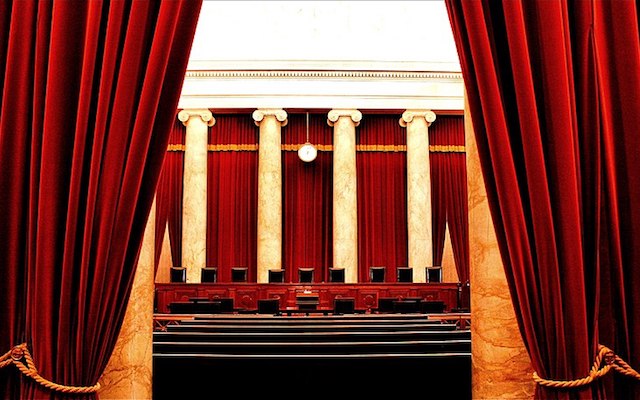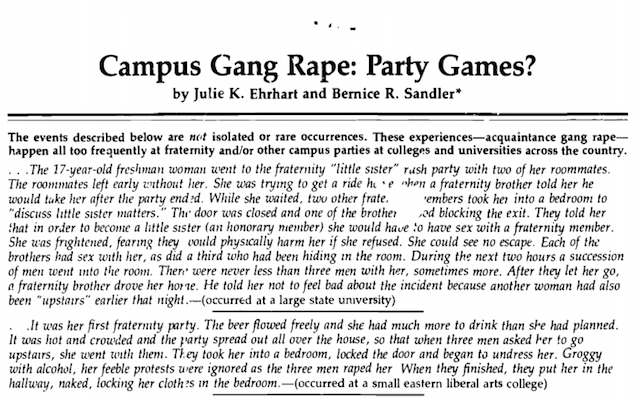Content note: This post discusses incidents of sexual violence.
This week brought news of a third sexual misconduct allegation against United States Supreme Court nominee Brett Kavanaugh. Julie Swetnick, also an alumnus of Georgetown Prep, alleges that she witnessed Kavanaugh participating in gang rapes at high school parties where drugs and alcohol were used to disorient women. Swetnick described the young men who participated as “lining up,” “waiting for their ‘turn’ with a girl inside the room.” In a White House statement, Kavanaugh dismissed these allegations as “ridiculous and from the Twilight Zone.” But 1980s cases of campus gang rape and responses to them suggest that Swetnick’s accusations are not ridiculous at all. Instead, her accusations reflect realities of 1980s American campus life. Here I show how the history of responses to campus gang rape can help us understand the allegation that Brett Kavanaugh participated in one.

Anthropologist Peggy Reeves Sanday wrote her 1990 book Fraternity Gang Rape: Sex, Brotherhood, and Privilege on Campus in response to a 1983 gang rape at the University of Pennsylvania. According to the book, she was part of the anti-rape movement beginning in the late 1960s. Her previous research compared band and tribal societies to understand the social contexts of rape-prone versus relatively rape-free societies. She found that a society’s incidence of rape was correlated with gender status and segregation, undermining arguments that men are biologically prone to rape. In Fraternity Gang Rape, she drew on this expertise to analyze one fraternity’s sexual practices and the personal, social, and historical contexts in which they participated in acts of gang rape.
Using a range of sources – conversations with administrators and journalists, interviews with fraternity men and partygoers, and first-person written accounts of students who had experiences in fraternities – Sanday argues that some exclusively male groups in male-segregated settings bond through sex. Her book shows how some men perform heterosexuality for one another to foster unity and a sense of belonging, affirm their masculinities, and transition together toward a shared vision of manhood. Women serve as tools for male bonding and displays of masculinity. Outside of the group, Sanday argues, “entrenched sexual inequality on a campus where fraternities had historically occupied a privileged place in campus social life” (p. 5) and a lack of consequences for sexual misconduct were conditions that promoted campus gang rape.
Of particular relevance for thinking about the third Kavanaugh misconduct allegation, Sanday began the introduction to Fraternity Gang Rape’s first edition by describing “pulling train”: an act in which men line up “like train cars to take turns having sex with the same woman” (p. 33). The fraternity men engaging in this practice also referred to it as “gang bang” or “express.” Perhaps obvious, when this sex is non-consensual, pulling train is gang rape. Sanday goes on to explain how this can happen at a party: “A vulnerable young woman, one who is seeking acceptance or who is high on drugs or alcohol, is taken to a room. She may or may not agree to have sex with one man. She then passes out, or is too weak or scared to protest, and a train of men have sex with her” (p. 33). There are striking similarities between the language Sanday uses here and Swetnick’s allegation. Drugs and alcohol are used to make a woman vulnerable. She is then brought to a room and men line up, inside or out, to have sex with her.
To explain “pulling train,” Sanday cited a 1985 report by Julie K. Ehrhart and Bernice Resnick Sandler of the Project on the Status and Education of Women (PSEW) titled “Campus Gang Rape: Party Games?” The Association of American Colleges (now Association of American Colleges and Universities) established PSEW in 1971 to improve gender equity in higher education. In the 1970s and 1980s, PSEW published many reports on sex discrimination, sexual harassment, the classroom climate for women, and acquaintance rape. “Campus Gang Rape” was written in response to recent incidents of gang rapes on campuses. It aimed to raise awareness of campus gang rapes, explicate roles of alcohol, drugs, and pornography in these incidents, describe some effective programs for rape prevention, and make recommendations for policies to address gang rape if/when it happened.

The report opens with four short descriptions of specific gang-rape incidents on college campuses, two of which read as pulling train. The names of universities where these incidents occurred are withheld, as Ehrhart and Sandler wanted to impress on the reader that gang rape was common at all kinds of schools. At the time “Campus Gang Rape” was published, PSEW knew of more than 50 incidents of gang rape at a range of colleges and universities. Most of these incidents involved fraternities, but some also involved college athletes or happened in dormitories. According to Ehrhart and Sandler, the young men engaging in these behaviors did not view them as rape. Instead, “they seem to regard it as ‘normal’ party behavior.” Similar to what Sanday found at the University of Pennsylvania, Ehrhart and Sandler describe gang rape participants’ beliefs that women who attended their parties and drank were “asking for it.” And that if her protests were unsuccessful, she was consenting.
PSEW’s “Campus Gang Rape” and Sanday’s Fraternity Gang Rape show us the dismay with which feminist scholars and advocates for equity in education responded to the disturbingly common sexual practice of gang rape on 1980s American college campuses. I concede that their work focused on college campuses, while the incident Swetnick has described was while she and Kavanaugh were in high school. That said, the broader findings of the PSEW report and of Sanday’s book – those regarding attitudes about, personal and social contexts of, and conditions that promote gang rape – can inform our understanding of allegations that U.S. Supreme Court nominee Brett Kavanaugh participated in a gang rape incident of pulling train. Far from ridiculous or pulled from the Twilight Zone, Julie Swetnick’s allegation is more legible when situated in a broader history of campus sexual violence and responses to it.
 Desiree Abu-Odeh is a history-track PhD candidate and Predoctoral Fellow in Gender, Sexuality, and Health in the Department of Sociomedical Sciences at Columbia University. Her research interests include histories of public health, gender, race, sexuality, and social movements in the United States. Desiree’s dissertation examines the sexual violence problem and anti-violence work on American college campuses from 1950 to 2000. She has received funding for her research from the Schlesinger Library on the History of Women in America, Barnard Library, and Smith College Libraries.
Desiree Abu-Odeh is a history-track PhD candidate and Predoctoral Fellow in Gender, Sexuality, and Health in the Department of Sociomedical Sciences at Columbia University. Her research interests include histories of public health, gender, race, sexuality, and social movements in the United States. Desiree’s dissertation examines the sexual violence problem and anti-violence work on American college campuses from 1950 to 2000. She has received funding for her research from the Schlesinger Library on the History of Women in America, Barnard Library, and Smith College Libraries.

NOTCHES: (re)marks on the history of sexuality is licensed under a Creative Commons Attribution-NonCommercial-NoDerivatives 4.0 International License.
Based on a work at www.notchesblog.com.
For permission to publish any NOTCHES post in whole or in part please contact the editors at NotchesBlog@gmail.com





Thank you so much for this.